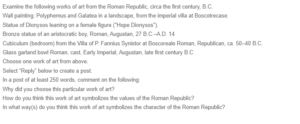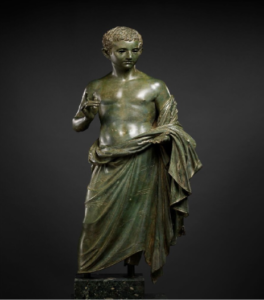Bronze Statue of an Aristocratic Boy
Figure: Bronze statue of an aristocratic boy Roman 27 BCE–14 CE
I selected the bronze statue of an aristocratic boy as the piece of art to analyze. The piece of art is a portrait of a young boy with curly hair and a bare chest covered with a cloak from the waist to the legs. The primary reason for choosing this piece of art is that its details really stood out for me. The curly hair, the realistic contour of his posture, and how the artist replicated how the cloth drops without flaws were amazing. I also find it astonishing that after several decades’ people still appreciate and value the statue. This statue gives a perfect picture and representation of the way the Roman habitants looked up to the Greek way of life and culture. First, the statue portrays the young boy wearing a cloak, a famous Greek fashion and not the ordinary toga that most Romans wore. Originally, this statue held something in his right hand; some speculate it was holding scrolls or writing vices. From the fact that the statue’s location is the island of Rhodes, a place commonly recognized for its schools of rhetoric and philosophy, it would be easy to conclude that the art was made to symbolize their love of rhetoric and philosophy. The statue represents the character of the Roman Republic through the bronze material the art is made of. The bronze material the art is made of gives reference to prosperity, wealth, and education depending on its Greek influences of posture, dress, and craft (Fichner-Rathus 116). Therefore, this art provides the observer with a clear indication of the boy’s social status and an excellent example of how Greek culture influenced Romans.
Reference
Fichner-Rathus, Lois. Understanding art. Cengage Learning. 2016
ORDER A PLAGIARISM-FREE PAPER HERE
We’ll write everything from scratch
Question

Bronze Statue of an Aristocratic Boy
Examine the following works of art from the Roman Republic, circa the first century, B.C.
Wall painting: Polyphemus and Galatea in a landscape, from the imperial villa at Boscotrecase.
Statue of Dionysos leaning on a female figure (“Hope Dionysos”).
Bronze statue of an aristocratic boy, Roman, Augustan, 27 B.C.–A.D. 14
Cubiculum (bedroom) from the Villa of P. Fannius Synistor at Boscoreale Roman, Republican, ca. 50–40 B.C.
Glass garland bowl Roman, cast, Early Imperial, Augustan, late first century B.C.
Choose one work of art from above.
Select “Reply” below to create a post.
In a post of at least 250 words, comment on the following:
Why did you choose this particular work of art?
How do you think this work of art symbolizes the values of the Roman Republic?
In what way(s) do you think this work of art symbolizes the character of the Roman Republic?



